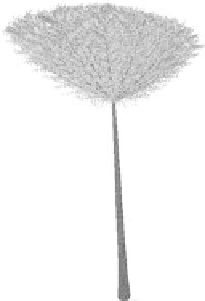Information Technology Reference
In-Depth Information
Fig. 7.3.
jEdit 4.3::jEdit. The tree represents a class with a large number of public
methods greater than private methods, a large number of lines of comment, a large
number of attributes, and few private methods.
LOCs
CLOCs
NOAs
NEMs
NOMs
NEOMs
JarBundler
713
465
35
50
22
72
BrowserIORequest
248
71
11
22
4
6
jEdit
2488
1043
28
94
24
118
Table 7.2.
Metrics of the sample classes.
Forests and their evolution.
All trees, which represent classes inside a
package, are placed in a rectangular box whose size is a function of the
number of trees. To provide visibility to the smaller trees, we place them
in front of the highest trees using a spiral pattern. In this way, the highest
trees will be placed in the middle of land squares and they will always be
visible regardless of the maintainer's point of view. Each spiral represents
a package of a subject system. It is also important to point out that we have
considered a package's structure in terms of contained classes.
If a class appears in many releases of the same software system, it will
always be shown at the same point on the ground of the forest
corresponding to these releases. The position is determined considering all
the classes present in all releases of the system and using the spiral pattern
above. Therefore, if a class is present in a release of the subject system the
corresponding tree is shown; otherwise it is not shown.
A Sample Forest.
An example of a forest as depicted within the tool is
shown in Fig. 7.4. The forest represents a software system composed of












Search WWH ::

Custom Search